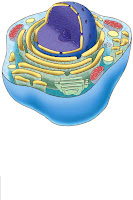The Cell Nucleus - An Evolutionary Mystery
The cells of animals, plants, fungi, and a great number of single-celled organisms like algae, amoebas, and paramecia are called "eukaryotic' cells. In a eukaryotic cell, a nucleus contains the According to the endosymbiont theory, certain organelles in eukaryotic cells, the chloroplasts and mitochondria, seem to be descendants of ancient bacteria. The chloroplasts are very similar to certain photosynthetic bacteria, and they perform photosynthesis in plant cells. The mitochondria are very similar to certain bacteria highly efficient at harvesting energy from various energy-rich molecules, and mitochondria perform the same function in plant and animal cells.
Figure 1: amoeba
Figure 2 : hydra
Lots of mysteries remain. Did other organelles descend from ancient bacteria? If so, what is the connection? If not, how did such organelles evolve? Eukaryotic cells contain movable skeletal structures, flagella for swimming, packing and shipping structures, digestive organelles-plenty of evolutionary mysteries. But a major question is Where did the nucleus come from and how did it come to its present structure? According the the endosymbiont theory, somehow the nucleus, chloroplasts, and mitochondria came together into a permanent symbiotic relationship. We know of likely bacterial ancestors for the chloroplasts and mitochondria, but what about the nucleus?
A nucleus in a present-day eukaryotic cell contains lots of, non-circular chromosomes-the number depends on the species. For instance, each fruit fly nucleus contains four pairs of chromosomes, each human nucleus contains twenty-three pairs. The chromosomes consist of DNA wrapped around histone proteins like thread wrapped around a spool. When genes on this DNA need to be copied into RNA, the DNA containing those genes unwinds.

Figure 3: cheek cells (the nucleus at the center of the cell)
The nucleus itself is enclosed in a double membrane that keeps the nuclear contents separate from the cytoplasm of the rest of the cell. This double membrane is peppered with pores to allow certain molecules through. RNA copies of genes, for instance, pass through such pores, out of the nucleus and into the cytoplasm. There they conduct the business of producing cell proteins.
The nucleus also contains apparatus and molecules for duplicating and dividing the chromosomes during cell-division, molecules for editing and perfecting copies of DNA and RNA, and much, much more. This complex organelle, the nucleus, like the chloroplasts and mitochondria, must have descended from some kind of prokaryotic cell. But is this ancestor still around? If so, we haven't found it, though some biologists are searching hard.
Julie Simon Lakehomer is writing a book about DNA. The book tells the life stories of thirteen geneticists, eager to ferret out the secrets of inheritance. These researchers committed themselves to conversation with the DNA universe until, revelation by revelation, they transformed what was known about heredity. Julie has a B.A. from The University of Chicago, and an M.S from the University of Illinois at Chicago. Julie is active in the American Association for the Advancement of Science, the National Science Teachers Association, the Association of Women in Science, Graduate Women in Science, the National Education Association, and the International Women's Writing Guild.







